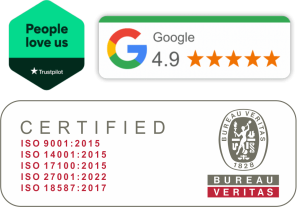Procedure and SOP Translation Services
Navigating Global Standards with Precision and Expertise


ENTRUST YOUR TRANSLATION PROJECTS TO US. HERE’S WHY:
At Skrivanek, we deeply understand the critical importance and complex nature of procedure translations along with SOP (standard operating procedure) translations within the global business ecosystem. In a world where the pillars of standardization and compliance hold significant weight, the meticulous translation of these documents transcends basic linguistic expertise, becoming a vital component in maintaining operational harmony and regulatory adherence across diverse international landscapes.
In the intricate tapestry of global business operations, the procedures and SOPs serve as the fundamental threads that ensure consistency and efficiency. Whether it is a multinational corporation or a smaller company venturing into new international markets, having clear, precise, and culturally attuned translation documents is indispensable. It ensures that every employee, regardless of their geographic location or cultural background, has a standardized roadmap for operational excellence.
Our role in this process is not merely that of a translator but that of a strategic partner, committed to upholding the integrity and efficacy of your operational protocols. We recognize that each word in a procedure or SOP can have significant implications, and even a minor misinterpretation can lead to operational discrepancies or compliance issues. Therefore, our approach combines linguistic accuracy with a deep understanding of the sector-specific requirements, ensuring that every translated document aligns perfectly with the original’s intent, technical specificity, and regulatory demands.


DO YOU SOP or PROCEDURE TRANSLATION!
WE ARE WAITING FOR A MESSAGE FROM YOU!
What are procedure and SOP translations?
Procedure translation: These are detailed step-by-step instructions that guide users in performing specific tasks or processes. They are essential in a wide range of industries, from manufacturing and healthcare to finance and technology. The accurate translation of procedures ensures that operational practices are consistent and effective, regardless of the geographical location.
SOP (standard operating procedure) translation: These are formal documents that outline the standardized processes to be followed in an organization. They play a critical role in maintaining quality control, ensuring safety, and providing a clear roadmap for employees to execute tasks efficiently and consistently. Translating SOPs accurately is vital for multinational companies in order to maintain uniformity in practices across their global operations.
Why choose Skrivanek?
- Specialized expertise: Our translators have specific industry knowledge, ensuring that technical and industry-specific terminology is accurately translated.
- Global compliance: We ensure that your translated procedures and SOPs adhere to both international and local regulations.
- Quality and precision: Our commitment to quality and attention to detail guarantees that your translated documents are both precise and easy to understand.
- Cultural sensitivity: We adapt your content to be culturally relevant to your target audience, maintaining the original document’s intent and integrity.
- Timely delivery: We understand the importance of deadlines and are dedicated to delivering your translations within your specified timeframe.
Our services in detail
Procedure and SOP translations are vital for:
- Ensuring global consistency: When you operate in multiple countries, it is essential that your procedures and SOPs are uniform and comprehensible to all employees, regardless of their location.
- Regulatory compliance: Accurate translations are necessary for adhering to local and international regulations, especially in heavily regulated industries.
- Training and onboarding: Well-translated procedures and SOPs are crucial for effective training and onboarding of international staff.
- Quality control: This helps to maintain high standards in terms of quality and safety across all branches of your business.
- Risk management: Clear and accurate translations minimize the risk of misunderstandings and errors in operational processes.
Cultural localisation
Although it’s not creative content, cultural adaptation also plays a significant role in SOP. What elements does SOP localisation include?
- Units of measurement and number formats
- Date and time formats (e.g., if a European employee saw the date 03/12/2025, he would probably read it as December 3rd, while an American employee would read it as March 12th)
- References to local regulations and standards (e.g., for the USA, these would be OSHA, FDA, or ANSI, and for Europe, ISO or EN)
- Symbols and pictograms – they may have different meanings in individual standards, but also simply within the culture
- Communication style and tone (e.g., more direct in the USA, more formal in Poland or Japan; important because it helps increase acceptance and understanding of documents among representatives of a given culture)
- Abbreviations (may be unreadable by people from different countries)
- Organizational structure and roles within the company (e.g., a QA Officer in the USA may be kierownik ds. zapewniania jakości in Poland)
These actions make employees more willing to follow guidelines, help avoid minor and major errors, and implement procedures faster (for example, there’s no need to look up the meaning of abbreviations online). They are also simply necessary in the case of audits – if the documents do not meet the standards applicable in a given country, they will not be accepted.
SOP Translation Process
Translating standard operating procedures (SOPs) requires precision, terminological consistency, and full compliance with industry standards. The translation process is typically similar to the specialised translation of other written content. It consists of the following stages:
1. Receiving the inquiry and providing an initial quote (usually within 30 minutes of obtaining the client’s message).
2. A thorough project analysis—helps determine:
- industry specifics;
- formal requirements (e.g., whether the text should comply with specific ISO, GMP, or HACCP standards);
- whether the file needs to be converted to an editable format;
- whether the document contains graphic elements with text that, after translation, will need to be added to a new version by a graphic designer (DTP specialist);
- whether any additional services will be required (e.g., preparing the document for printing).
3. Agreeing on all the details with the client and signing a contract.
4. Selecting the right translator— one with extensive industry knowledge and experience in this type of translation.
5. Creating a glossary containing key terms and their translations—helps maintain terminological consistency at all levels and reduces the risk of critical errors. This is usually prepared in collaboration with the client.
6. Translation, often using CAT (computer-assisted translation) tools and translation memories, which helps speed up the process and further enhance consistency.
7. Proofreading, which aims to remove spelling, punctuation, and stylistic errors and to edit the text so that it sounds as fluent and natural as the original. Independent review is also possible; it’s performed by a second translator, also a specialist in the field, who corrects the text for semantic, substantive, and terminological consistency.
8. If the text is intended for print or electronic publication and/or contains images with the text, computer typesetting is performed. This may include accurately reproducing the original. After DTP processing, a pre-print proofing is performed, which focuses on formatting and editorial errors (e.g., incorrect word hyphenation).
9. Internal quality assurance of translation—this is to identify any final errors, such as translation omissions or typos.
10. The text is returned to the client, who accepts it or provides comments.
Translation support is also provided if standard operating procedures are updated.
We ensure compliance with international standards at all stages. These include ISO 9001 (high customer service standards), ISO 27001 (appropriate information security management), and EN 17100 (the highest possible quality of written translations, compliant with European Union standards).
Contact us!
Our team of experts is not only linguistically proficient but also well-versed in a multitude of industries. This blend of skills enables us to deliver translations that respect the technical elements and sector-specific jargon inherent in procedures and SOPs. Furthermore, we are acutely aware of the cultural sensitivities and local regulations that may impact how these documents are received and interpreted in different regions.
In partnering with Skrivanek, you are choosing a service that places paramount importance on accuracy, reliability, and cultural relevance. We are dedicated to ensuring that your global communication is as effective and impactful as possible, supporting the continuous growth and international success of your business.
